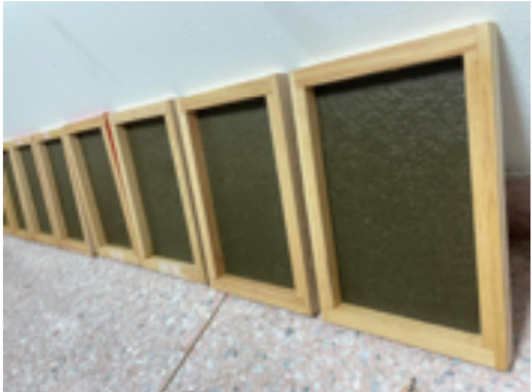The Feasibility Study on Using Indigo Residues from the Natural Dye Extraction Process to Produce Handicraft Paper
DOI:
https://doi.org/10.60136/bas.v12.2023.392Keywords:
Indigo residues, Chemical composition, Handicraft paperAbstract
Indigo (Indigofera tinctoria L.) is a shrub belonging to the Leguminosae family. It prefers sunlight and little water and mostly grows in the north and northeast of Thailand. Indigo is considered the well-known textile dye in textile industry due to its beautiful and durable color. After the production of dye color from the indigo, a large amount of indigo stem has been discarded as waste. This research thus aims to study the feasibility of using indigo residues from dye extraction process as raw material in handicraft paper production to reduce the amount of waste and add value to indigo stem waste. Indigo wastes after dye extraction was analyzed the chemical compositions and pulped by soda pulping process. The indigo pulp properties were further improved by beating. Then, handicraft sheets was formed and tested for the physical and optical properties. The paper bag packaging prototype was subsequently made from these indigo handicraft sheets. The results showed that the amount of holocellulose was 28.6% and lignin was 12.1%. The indigo pulp after soda pulping had 58.3% yields and had 190 mL CSF freeness after being beaten for 3 minutes. The pulp could be formed into handicraft paper without extra additives addition. The handicraft paper made from stem mixed with leave had tensile index of 9.63 Nm/g, tear index of 8.28 mN.m2/g and burst index 0.69 kPa.m2/g. The paper bag made from this handicraft paper could be used to carry the light-weighted item.
References
มหาวิทยาลัยอุบลราชธานี, สำนักวิทยบริการ งานข้อมูลท้องถิ่น. คราม: ไม้ย้อมสีธรรมชาติ [อินเทอร์เน็ต]. [ม.ป.ป.] [เข้าถึงเมื่อ 3 พฤศจิกายน 2565]. เข้าถึงได้จาก: http://www.esanpedia.oar.ubu.ac.th/tint/?page_id=59
สำนักงานคณะกรรมการพิเศษเพื่อประชาชน โครงการอันเนื่องมาจากพระราชดำริ, คู่มือการผลิตผ้าย้อมคราม [อินเทอร์เน็ต]. พิมพ์ครั้งที่ 2. กรุงเทพฯ: บริษัทมูฟเม้นท์ เจน ทรี จำกัด; 2555 [เข้าถึงเมื่อ 27 ตุลาคม 2565]. เข้าถึงได้จาก: https://www.rdpb.go.th/UploadNew/Documents/ผ้าย้อมคราม.pdf
กรมส่งเสริมการเกษตร. ระบบสารสนเทศการผลิตทางด้านเกษตร สมุนไพรและเครื่องเทศ (คราม) ปี 2562 [อินเทอร์เน็ต]. 2563 [เข้าถึงเมื่อ 9 พฤศจิกายน 2564]. เข้าถึงได้จาก: https://production.doae.go.th
เกษตรอินเทรน. ปลูกครามแซมสวนหม่อน หนึ่งช่องทางเสริมรายได้ของเกษตรกรผู้ปลูกหม่อนเลี้ยงไหม [อินเทอร์เน็ต] 2560 [เข้าถึงเมื่อ 3 พฤศจิกายน 2565] เข้าถึงได้จาก: https://www.sentangsedtee.com/farming-trendy/article_37502
ครองใจ โสมรักษ์, พิจิกา ทิมสุกใส, สุจินต์ เจนวีรวัฒน์. อิทธิพลของอายุเก็บเกี่ยวต่อผลผลิตและคุณภาพของเมล็ดพันธุ์คราม. วารสารเกษตรพระจอมเกล้า. 2563;38:426-33
Henriksson G, Brannvall E, Lennholm H. The Trees. In Ek M, Gellerstedt G, Henriksson G, editors. Pulp and paper chemistry and technology volume 1 wood chemistry and wood biotechnology. Stockholm: School of Chemical Science and Engineering Royal Institute of Technology; 2009 p.13-44.
Ferdous T, Ni Y, Quaiyyum MA, Uddin MN, Jahan MS. Non-wood fibers: Relationships of fiber properties with pulp properties. ACS Omega 2021;6:21613-22.
Kawase K. Chemical components of wood decayed under natural condition and their properties. J Fac Agric Hokkaido Univ.1962;52:186-245.
Shakhes J, Zeinaly F, Marandi M, Saghafi T. The Effects of processing variables on the soda and soda-AQ pulping of kenaf bast fiber. BioResources 2011;6:4626-39.
Leponiemi A. Non-wood pulping possibilities – a challenge for the chemical pulping industry. Appita J. 2008;61:234-43.
Sehaqui H, Zhou Q, Berglund L.A. Nanofibrillated cellulose for enhancement of strength in high- density paper structures. Nord Pulp Pap Res J. 2013;28:182-89.
Ardsamang T, Puthson P, Somboon P. Effect of long-fiber hardwood kraft pulp from Baccaurea ramiflora Lour. on handsheet properties of pulp blends. Agric Nat Resour. 2020;54:287-94.
สำนักงานมาตรฐานผลิตภัณฑ์อุตสาหกรรม (สมอ). มาตรฐานผลิตภัณฑ์อุตสาหกรรมกระดาษเหนียว. มอก.170-2550. กรุงเทพฯ: สมอ.; 2550.

Downloads
Published
How to Cite
Issue
Section
License
Copyright (c) 2023 Bulletin of Applied Sciences

This work is licensed under a Creative Commons Attribution-NonCommercial-NoDerivatives 4.0 International License.









